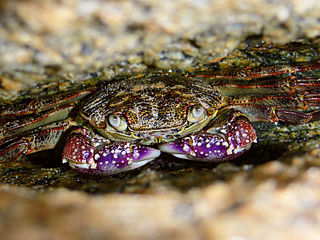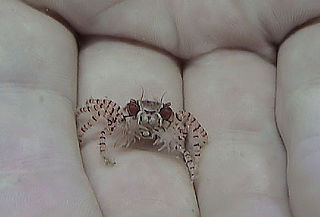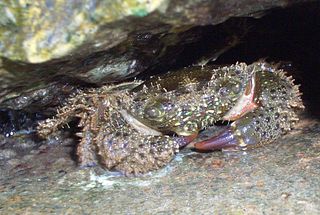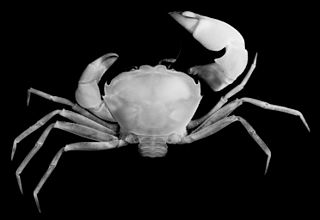
Mictyris is a genus of brightly coloured crabs, placed in its own taxonomical family, the Mictyridae. It inhabits the central Indo-West Pacific region. These crabs congregate on mud flats or beaches in groups of a few thousand, and filter sand or mud for microscopic organisms. They congregate during low tide, and bury themselves in the sand during high tide or whenever they are threatened. This is done in wet sand, and they dig in a corkscrew pattern, leaving many small round pellets of sand behind them.

The stalk-eyed mud crab is a marine large-eyed crab of the family Macrophthalmidae, endemic to New Zealand including Campbell Island. It grows to around 30 millimetres (1.2 in) shell width. It is either the only species in the subgenus Hemiplax and the most basal species in the genus Macrophthalmus, or the only species in the sister genus Hemiplax.

Leptograpsus variegatus, known as the purple rock crab, is a marine large-eyed crab of the family Grapsidae, found in southern subtropical Indo-Pacific Oceans. It grows to around 50 millimetres (2.0 in) shell width. It is the only species in the genus Leptograpsus.

The red rock crab, Guinusia chabrus, is a marine large-eyed crab of the family Plagusiidae. It is found in the southern Indian and southern Pacific Oceans, including South Africa, Australia, New Zealand, and Chile.

Plagusia squamosa is a marine crab of the family Plagusiidae, formerly considered a subspecies of Plagusia depressa. It is found in tropical Indo-Pacific oceans. P. squamosa's carapace is bumpy and quite coarse, seemingly scaly, leading to its common name: The Scaly Rock Crab.

Xanthoidea is a superfamily of crabs, comprising seven families. Formerly, a number of other families were included in Xanthoidea, but many of these have since been removed to other superfamilies. These include Carpilioidea, Eriphioidea, Hexapodoidea, Pilumnoidea and Trapezioidea. Even in this reduced state, Xanthoidea remains one of the most species-rich superfamilies of crabs.

Discoplax is a genus of terrestrial crabs. It is very closely related to the genus Cardisoma.

Lybia is a genus of small crabs in the family Xanthidae. Their common names include boxer crabs, boxing crabs and pom-pom crabs. They are notable for their mutualism with sea anemones, which they hold in their claws for defense. In return, the anemones get carried around, which may enable them to capture more food particles with their tentacles. Boxer crabs use at least three species of anemones, including Bundeopsis spp. and Triactis producta. The bonding with the anemone is not needed for survival, however, and boxer crabs have frequently been known to live without them, sometimes substituting other organisms such as sponges and corals for the sea anemones.

Eriphia is a genus of marine crustaceans in the family Eriphiidae.

The Plagusiidae are a family of crabs, formerly treated as a subfamily of the family Grapsidae, but have since been considered sufficiently distinct to be a family in their own right. The family Plagusiidae includes the subfamily Plagusiinae, comprising the genera Percnon and Plagusia, which constitute a widespread group of litophilic, intertidal and subtidal crabs that are notorious for their speed and their agility.

Pseudozioidea is a superfamily of crabs, formerly treated in the Eriphioidea, Carpilioidea, Xanthoidea, Pilumnoidea and Goneplacoidea. A number of fossils from the Eocene onwards are known from the family Pseudoziidae. Eleven genera are recognised in three families:

Palicoidea is a superfamily of crabs, comprising the two families Crossotonotidae and Palicidae. Together, they contain 13 genera, including two genera in the Palicidae known only from fossils. The two families were previously treated as two subfamilies in a Palicidae of wider circumscription.

Liocarcinus navigator is a species of crab in the family Portunidae.

Rata is a genus of crabs in the family Xanthidae, containing the following species:

Pisa is a genus of crabs, containing the following species:

The Macrophthalmidae, commonly referred to as sentinel crabs, are a family of crabs, comprising these subfamilies and genera:
Mictyris guinotae is a species of soldier crab of genus Mictyris, endemic to the Ryukyu Islands of Japan. They were named after Danièle Guinot, a professor at the Muséum national d'histoire naturelle in France, and were first treated as a separate species in a tribute volume to Guinot.

Heikeopsis is a genus of crabs containing two species, Heikeopsis japonica and Heikeopsis arachnoides. The genus was originally described under the name "Heikea" by Lipke Holthuis and Raymond B. Manning in 1990, but was later determined to be a junior homonym of the gastropod genus Heikea, erected by Orvar Isberg in 1934.


















